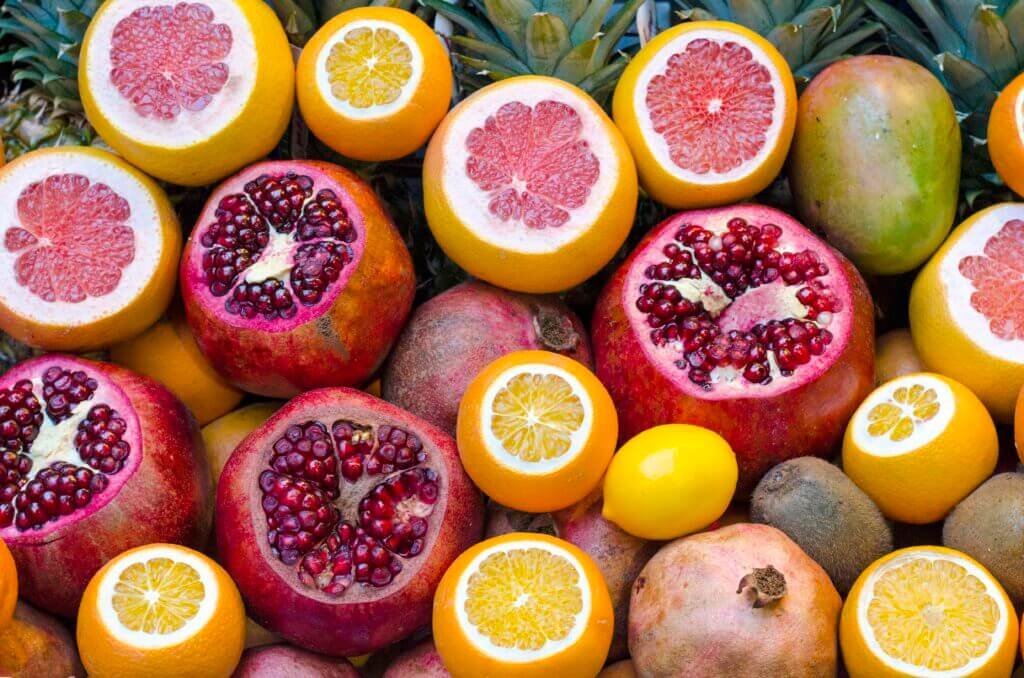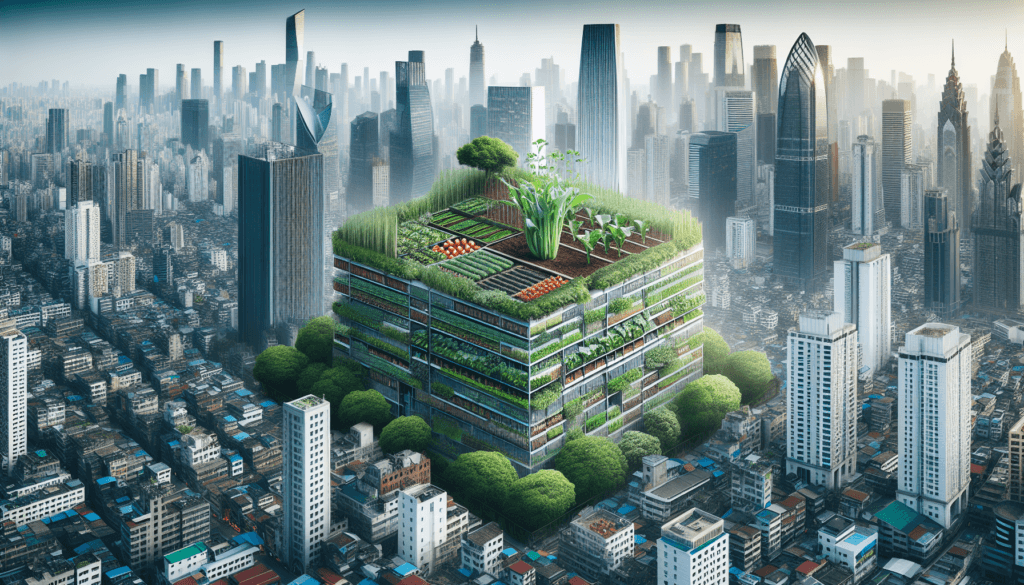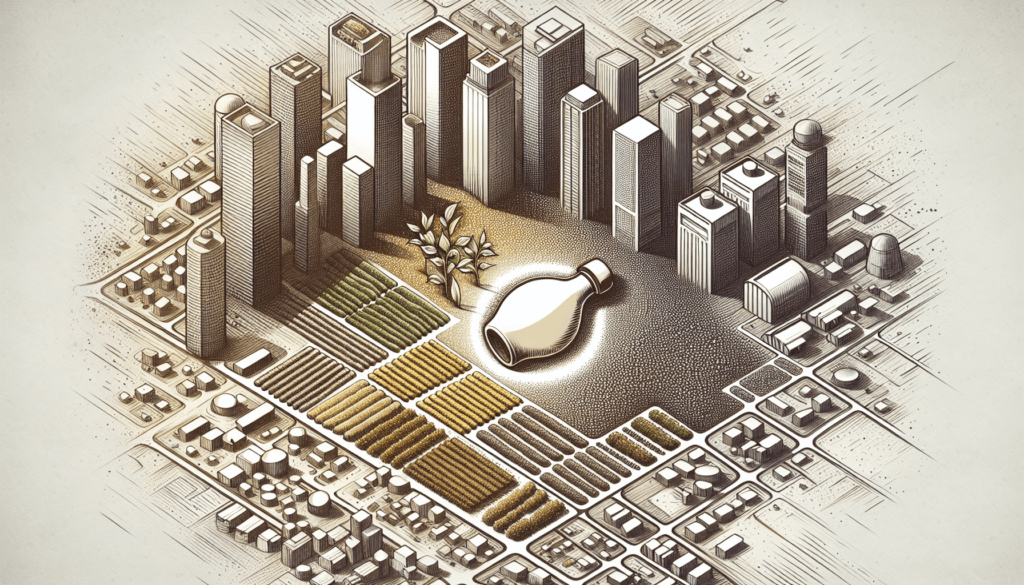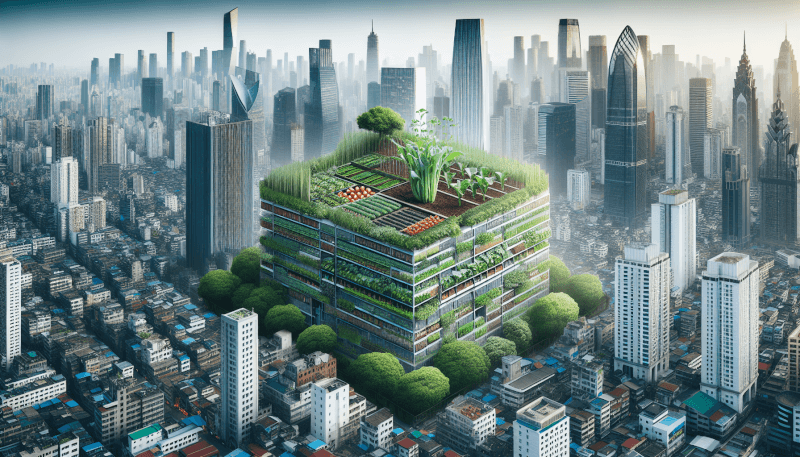Growing your own food may seem like a dream reserved for those with sprawling countryside fields, but is it possible to farm in an urban area? In recent years, urban farming has gained popularity as people look for ways to reconnect with nature and reduce their carbon footprint. By utilizing innovative techniques such as vertical gardening, rooftop farms, and community gardens, urban dwellers are discovering that growing their own produce is not only feasible but also economically and environmentally beneficial. So, put your green thumbs to work and join the urban farming movement, bringing fresh and sustainable food right to your doorstep.

Benefits of Urban Farming
Access to Fresh and Locally Grown Food
Urban farming provides individuals and communities with the opportunity to access fresh and locally grown food. Instead of relying on produce that has traveled long distances and undergone extensive processing, urban farming allows you to harvest vibrant fruits, vegetables, and herbs right in your own neighborhood. This not only ensures that you’re consuming the freshest possible produce, but also reduces your carbon footprint by minimizing transportation and packaging waste.
Community Engagement and Empowerment
One of the remarkable benefits of urban farming is its ability to foster community engagement and empowerment. By participating in or supporting urban farming initiatives, individuals can connect with their neighbors, share knowledge, and build trust. Community gardens, for example, often serve as meeting places where people from diverse backgrounds come together to work towards a common goal. This sense of unity promotes social interaction and strengthens community ties, ultimately leading to a more vibrant and inclusive neighborhood.
Environmental Sustainability
Urban farming plays a vital role in promoting environmental sustainability. By utilizing empty lots, rooftops, and even vertical spaces, urban farming helps make the most efficient use of available land in densely populated areas. This practice reduces urban sprawl and the encroachment of agricultural land, thus safeguarding natural ecosystems and preserving biodiversity. Furthermore, urban farms often implement sustainable practices such as composting, rainwater harvesting, and organic farming methods, minimizing the use of harmful chemicals and promoting soil health.
Economic Opportunities
Another significant advantage of urban farming is the creation of economic opportunities for individuals and communities. Urban agriculture can serve as a viable source of income, particularly for those living in underserved or economically disadvantaged areas. By cultivating and selling their own produce, urban farmers can generate income, support their families, and contribute to local economic growth. Moreover, urban farming can also stimulate other business opportunities, such as farm-to-table restaurants, farmers’ markets, and value-added processing enterprises.
Health and Well-being Benefits
Engaging in urban farming can have numerous health and well-being benefits. Tending to a garden or participating in a community farm allows you to engage in physical activity and spend time outdoors, which can improve fitness levels and mental well-being. Additionally, consuming fresh and nutrient-rich produce from urban farms provides essential vitamins, minerals, and antioxidants that contribute to a healthy diet. Urban farming also promotes food security by increasing access to nutritious food options, reducing reliance on unhealthy processed foods, and combating food deserts in urban areas.
Challenges of Urban Farming
Limited Space
A significant challenge faced by urban farmers is the limited availability of space. Urban environments are typically characterized by high population densities and limited land resources, making it challenging to find suitable areas for agricultural activities. However, innovative urban farming techniques such as vertical farming and rooftop gardens have emerged to overcome space constraints and maximize agricultural productivity.
Land Availability and Cost
Obtaining land for urban farming can be a major hurdle due to limited availability and high costs. Urban areas are often governed by restrictive zoning regulations and require substantial financial investments to secure suitable land. However, urban farmers have found creative solutions to this challenge by utilizing unused spaces such as vacant lots, abandoned buildings, and even vertical structures like walls or balconies to grow their crops.
Regulatory and Zoning Restrictions
Urban farming is subject to various regulatory and zoning restrictions depending on local laws and regulations. These restrictions aim to address issues such as noise, odor, waste management, and animal husbandry. However, outdated regulations and lack of clarity can impede the growth of urban farming. Advocacy and collaboration with local authorities are essential in promoting the development of supportive policies that enable urban farming to thrive.
Infrastructure Requirements
Urban farming often requires specific infrastructure to facilitate operations. Adequate water supply, irrigation systems, lighting, and climate control are crucial for successful crop production. These infrastructure requirements can be costly and complex to implement, especially in densely populated urban areas where space is limited. However, advancements in technology have made it increasingly feasible to create efficient and sustainable urban farming systems.
Pest and Disease Control
Managing pests and diseases is a constant challenge in urban farming. The proximity of buildings and increased human activity can attract pests and promote the spread of diseases. Urban farmers need to adopt integrated pest management practices that focus on prevention, monitoring, and using environmentally friendly control methods. Regular crop inspections, proper sanitation practices, and the use of biological pest control agents can mitigate the risks associated with pests and diseases in urban farming.
Types of Urban Farming
Rooftop Farms
Rooftop farms utilize the unused space on buildings to cultivate a variety of crops. These farms often employ innovative techniques such as hydroponics or container gardening, allowing for efficient use of space and resources. Rooftop farms not only provide fresh produce but also contribute to energy efficiency by reducing heat absorption and providing insulation for the building.
Vertical Farms
Vertical farming takes advantage of vertical space to grow crops in stacked layers or vertically inclined structures. By utilizing artificial lighting, hydroponic or aeroponic systems, and advanced climate control technology, vertical farms can maximize the production of crops in a small footprint. This technique is particularly suitable for high-rise buildings or urban areas with limited horizontal space.
Indoor Hydroponic Systems
Indoor hydroponic systems involve growing plants without soil, with nutrient-rich water serving as the medium for plant growth. These systems can be set up in controlled indoor environments, making them ideal for urban farming. Hydroponic systems are highly efficient, using less water and space than traditional soil-based farming methods, and allowing for year-round crop production regardless of weather conditions.
Community Gardens
Community gardens are collaborative projects where individuals or groups collectively cultivate a piece of land, typically located in urban areas. These gardens serve as communal spaces where people can grow their own food, exchange knowledge, and foster a sense of community. Community gardens not only provide fresh produce but also offer opportunities for social engagement, education, and urban greening.
Window Farms
Window farms involve growing crops in vertical structures made up of stacked containers positioned near windows. These farms are often set up in small urban apartments or spaces with limited outdoor access. Window farms utilize natural light and a hydroponic system to grow plants, allowing individuals to cultivate fresh produce in their own homes.
Urban Farming Techniques
Container Gardening
Container gardening is a versatile technique that allows plants to be grown in various types of containers such as pots, buckets, or raised beds. It is particularly suitable for urban areas with limited space, as containers can be placed on balconies, rooftops, or windowsills. This technique enables individuals to grow a wide range of crops, including herbs, vegetables, and flowers, in a cost-effective and accessible manner.
Hydroponics
Hydroponics is a soilless farming technique that involves growing plants in nutrient-rich water. This method allows for precise control of nutrient levels, water usage, and environmental conditions, resulting in higher crop yields and faster growth rates. Hydroponics is an efficient urban farming technique as it requires less space, fewer resources, and can be implemented indoors.
Aquaponics
Aquaponics combines aquaculture (fish farming) with hydroponics in a symbiotic system. In aquaponics, plants and fish coexist, with the fish waste providing nutrients for the plants, while the plants filter and purify the water for the fish. This closed-loop system minimizes water usage and creates a sustainable ecosystem where both fish and plants thrive. Aquaponics is a popular urban farming technique as it maximizes resource utilization and requires minimal external inputs.
Aeroponics
Aeroponics is a cutting-edge urban farming technique that involves suspending plant roots in air and misting them with a nutrient-rich solution. By misting the roots directly, aeroponics promotes rapid growth and allows for more efficient nutrient absorption. This technique is highly space-efficient, as it eliminates the need for soil or containers, and allows plants to grow vertically, maximizing agricultural productivity in urban environments.
Vertical Gardening
Vertical gardening involves growing plants vertically against walls or structures using various support systems. This technique is particularly useful when dealing with limited horizontal space, as it allows plants to grow upwards instead of spreading outwards. Vertical gardening can be implemented using a variety of methods, such as trellises, stakes, or modular systems, and enables urban farmers to make the most of available space while adding aesthetic appeal to their surroundings.

Choosing Suitable Crops for Urban Farming
Leafy Greens and Herbs
Leafy greens and herbs are excellent choices for urban farming due to their compact growth habits and relatively quick harvest times. Crops such as lettuce, spinach, kale, and herbs like basil, mint, and parsley can be grown in containers, hydroponic systems, or vertical gardens, making them ideal for small urban gardens or even indoor environments.
Microgreens
Microgreens are young and tender edible plants harvested at the seedling stage. These nutrient-dense greens are packed with flavor and can be grown in shallow trays or containers. Microgreens are well-suited for urban farming as they require minimal space and grow quickly, allowing for continuous harvests throughout the year.
Mushrooms
Mushroom cultivation can be an ideal option for urban farming, as mushrooms grow in controlled indoor environments and do not require sunlight. Varieties such as oyster mushrooms or shiitake can be grown in small spaces using substrates like sawdust or coffee grounds, making them excellent choices for urban farmers looking to diversify their crops.
Root Vegetables
Root vegetables like carrots, radishes, and beets can be grown in containers, raised beds, or urban gardens with loose and well-drained soil. These crops can utilize vertical gardening techniques, where the roots grow downwards while the foliage grows upwards. With careful planning and suitable soil conditions, root vegetables can successfully be grown in urban environments.
Strawberries and Other Berries
Strawberries and other berries are small fruiting crops that can thrive in urban farming settings. These plants can be grown in containers, hanging baskets, or vertical systems. Furthermore, berries can be enjoyed fresh or used in various culinary applications, making them a popular choice among urban farmers looking to add a burst of flavor to their gardens.
Essential Factors for Successful Urban Farming
Sunlight Availability
Access to sufficient sunlight is crucial for the growth of plants in urban farming. When selecting the location for your urban farm, consider areas that receive adequate natural light or implement artificial lighting solutions such as LED grow lights. Proper positioning of crops and precise timing of light exposure can ensure optimal photosynthesis and overall plant health.
Water Supply and Irrigation
A reliable water supply and efficient irrigation system are essential for urban farming success. Depending on the scale of your operation, access to clean water sources, such as rainwater harvesting or municipal water, needs to be ensured. Implementing efficient irrigation methods, like drip irrigation or hydroponic systems, can minimize water usage and reduce the risk of water-related issues such as over or under watering.
Soil Quality and Fertilization
Urban farmers must ensure the fertility and quality of their soil to support healthy plant growth. Conducting a soil test can provide valuable insights into nutrient deficiencies or imbalances, allowing for appropriate adjustments. Organic matter, compost, and other soil amendments can be used to improve soil structure, moisture retention, and nutrient levels. Regular fertilization, following organic or sustainable practices, is crucial in replenishing nutrients and maintaining soil health.
Pest and Disease Management
Developing an integrated pest and disease management strategy is fundamental to protect crops in urban farming. Practices such as crop rotation, companion planting, and physical barriers can minimize pest pressure naturally. Regular monitoring, early detection, and the targeted use of organic or biological pest control methods can effectively manage pests and diseases without relying on harmful chemicals.
Climate Control
Urban farming often requires climate control measures to compensate for the limitations imposed by urban environments. This could involve the use of artificial lighting, ventilation systems, or heating and cooling units to maintain ideal growing conditions. Monitoring and adjusting temperature, humidity, and airflow are critical factors in ensuring crop success and avoiding stress-related issues caused by fluctuations in environmental conditions.

Urban Farming in Limited Spaces
Container and Vertical Gardening
Container and vertical gardening are practical solutions for urban farming in limited spaces. By utilizing containers, pots, or vertical structures, such as trellises or modular systems, urban farmers can maximize the use of available space while incorporating aesthetically pleasing greenery into their surroundings. These methods are versatile and suitable for growing a wide range of crops, from herbs and leafy greens to small fruiting plants.
Windowsills and Balconies
Windowsills and balconies offer urban farmers the opportunity to transform these small spaces into vibrant gardens. By utilizing hanging baskets, window boxes, or compact containers, individuals can grow an array of plants, whether it be herbs, microgreens, or small vegetables. Maximizing natural light and ensuring proper drainage are key considerations for successful urban farming in windowsills and balconies.
Green Walls
Green walls, also known as vertical gardens or living walls, are innovative urban farming solutions that transform vertical surfaces into flourishing gardens. These walls can be installed both indoors and outdoors, and incorporate a variety of plants, such as ferns, herbs, or even fruits and vegetables. Green walls not only maximize space but also offer insulation, noise reduction, and aesthetic benefits, making them an attractive option for urban dwellers.
Utilization of Rooftop Space
Rooftop spaces are often overlooked areas that have the potential for urban farming. By employing techniques such as rooftop gardens or rooftop farms, urban farmers can take advantage of the unused space and direct sunlight to grow a diverse range of crops. Rooftop farming not only contributes to food production but also offers insulation benefits, reduces stormwater runoff, and provides a habitat for wildlife in urban areas.
Vertical Stacking Systems
Vertical stacking systems, such as tower gardens or modular vertical farms, are space-efficient solutions for urban farming. These systems involve vertically arranged layers or columns of crops, allowing for the cultivation of numerous plants in a compact footprint. Vertical stacking systems utilize hydroponic or aeroponic techniques and provide optimal conditions for plants to thrive, making them an excellent choice for vertical urban farming.
The Role of Technology in Urban Farming
Internet of Things (IoT) Sensors
The Internet of Things (IoT) technology plays a crucial role in urban farming by enabling real-time monitoring and data collection. Equipped with sensors, urban farms can measure environmental variables such as temperature, humidity, light levels, and nutrient levels. These data points allow farmers to optimize growing conditions, detect anomalies, and make informed decisions to enhance crop productivity and resource management.
Automated Systems
Automation systems have revolutionized urban farming by reducing manual labor and improving efficiency. Automated systems can handle tasks such as irrigation, fertilization, and lighting, ensuring precise control and consistent crop quality. By employing robotics and automated processes, urban farmers can streamline operations, save time, and increase productivity.
Data Analysis and Artificial Intelligence
The analysis of collected data and the implementation of artificial intelligence (AI) algorithms play a vital role in optimizing urban farming operations. By utilizing AI-based models, farmers can gain valuable insights into crop growth patterns, optimize resource allocation, and implement predictive analytics for more robust decision-making. Data analysis and AI technologies enable urban farmers to maximize productivity, conserve resources, and minimize environmental impact.
Energy-Efficient Lighting Systems
Energy-efficient lighting systems, such as LED grow lights, are integral to indoor and vertical urban farming. LED lights provide specific wavelengths of light required for plant photosynthesis while consuming significantly less energy compared to traditional lighting systems. These energy-efficient lighting solutions are long-lasting, emit less heat, and allow for precise control, making them essential for year-round crop production in urban farming.
Smart Irrigation Systems
Smart irrigation systems are designed to optimize water usage in urban farming. These systems incorporate sensors, weather data, and automation to deliver the right amount of water at the right time. By ensuring accurate irrigation, avoiding water waste, and minimizing runoff, smart irrigation systems are key to sustainable urban farming practices. These systems can be tailored to individual crops, soil types, and specific environmental conditions, promoting plant health and conserving water resources.

Community Involvement and Support
Partnerships with Local Businesses and Restaurants
Developing partnerships with local businesses and restaurants is essential for the success of urban farming initiatives. Urban farmers can supply fresh and locally grown produce to restaurants, cafes, and grocery stores, fostering a sustainable local food system. These partnerships benefit both parties, as businesses can showcase their commitment to supporting local agriculture, while farmers gain a consistent market for their produce.
Community Supported Agriculture (CSA)
Community Supported Agriculture (CSA) programs allow individuals from the community to support local farmers by purchasing shares or subscription boxes of fresh produce. CSA programs provide farmers with financial stability and community members with access to locally grown food. This direct connection between farmers and consumers promotes transparency, reduces reliance on long supply chains, and strengthens the local food economy.
Educational Programs and Workshops
Educational programs and workshops play a crucial role in promoting urban farming and empowering individuals with the knowledge and skills necessary to engage in this practice. These programs can cover a wide range of topics, including gardening techniques, sustainable farming practices, and the importance of local food systems. By offering educational opportunities, urban farmers can inspire others to create their own gardens and contribute to a more sustainable urban environment.
Urban Farming Cooperatives
Urban farming cooperatives bring together individuals or groups who share resources, knowledge, and expertise to collectively cultivate land and market their produce. These cooperative models provide individuals with a sense of community and support, enabling them to overcome challenges associated with urban farming. By sharing costs, labor, and resources, urban farming cooperatives create a sustainable platform for collective success.
Policy Advocacy and Government Support
Advocacy for supportive policies and government support are crucial for the growth and expansion of urban farming. Engaging with local authorities and policymakers to address regulatory hurdles, promote resource allocation, and encourage the integration of urban farming within urban planning is essential. Government support in the form of funding, grants, and incentives can significantly contribute to the development and success of urban farming initiatives.
Success Stories of Urban Farming
Brooklyn Grange in New York City
Brooklyn Grange is one of the most renowned urban farming success stories, transforming rooftops in New York City into productive farms. With locations in Brooklyn and Queens, Brooklyn Grange cultivates a wide variety of organic produce, such as greens, herbs, and tomatoes, over a total of four acres of rooftop space. By providing fresh and locally grown food to the community, Brooklyn Grange has become a leader in urban farming and a model for sustainable agriculture in densely populated urban areas.
Growing Underground in London
Growing Underground is a pioneering urban farming project located in London, UK. This project utilizes underground tunnels to cultivate a range of crops, including microgreens and salad leaves, year-round. By utilizing hydroponics and energy-efficient LED lighting, Growing Underground maximizes space and minimizes environmental impact. This innovative approach to urban farming showcases the potential for utilizing unconventional spaces and techniques to grow food sustainably in urban environments.
Shanghai Skyfarm in China
Shanghai Skyfarm is an ambitious vertical farm project in China that aims to revolutionize urban agriculture. This vertical farm, designed by architectural firm Rogers Stirk Harbour + Partners, is set to be the world’s largest vertical farm, producing 1,000 tons of fresh vegetables annually. By integrating advanced technology, sustainable practices, and efficient vertical farming systems, Shanghai Skyfarm aims to address food security and promote sustainable urban development.
Agricool in Paris
Agricool, based in Paris, France, is a leading urban farming company specializing in the cultivation of strawberries inside repurposed shipping containers. Utilizing hydroponics and LED lighting, Agricool has created a sustainable and controlled environment for strawberry production. By growing strawberries locally, year-round, Agricool reduces the reliance on imported produce, minimizes environmental impact, and provides the community with fresh and flavorful strawberries throughout the year.
UrbanFarmers in Switzerland
UrbanFarmers, headquartered in Switzerland, is a pioneering company that focuses on aquaponic farming in urban environments. Their flagship project, located in Basel, involves the transformation of a former brewery into a sustainable and productive urban farm. UrbanFarmers combines fish rearing with hydroponic vegetable production, creating a closed-loop system where fish waste provides nutrients for the plants, and the plants purify the water. This innovative approach to urban farming showcases how aquaponics can transform underutilized urban spaces into productive and sustainable farms.
In conclusion, urban farming offers numerous benefits such as access to fresh and locally grown food, community engagement, environmental sustainability, economic opportunities, and health and well-being benefits. However, it also presents challenges such as limited space, land availability and cost, regulatory restrictions, infrastructure requirements, and pest and disease control. With a wide range of urban farming techniques, suitable crop choices, and essential factors for success, individuals and communities can overcome these challenges and thrive in limited urban spaces. Technology, community involvement and support, and success stories from around the world further highlight the potential and opportunities within urban farming. By embracing urban farming, we can create greener, healthier, and more sustainable cities.


